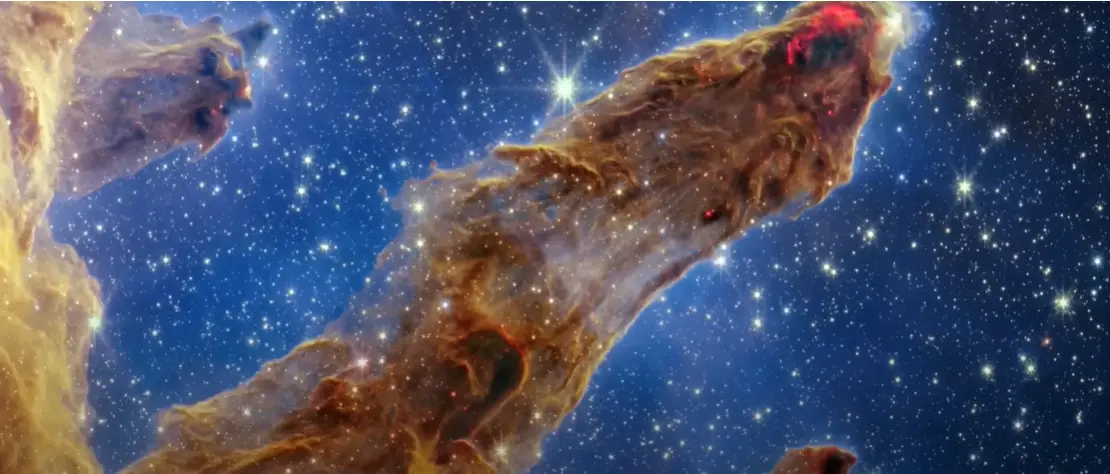The Pillars of Creation are one of the most breathtaking images ever captured by the James Webb Space Telescope. The towering tendrils of cosmic dust and gas, spanning around 4 to 5 light-years, are one of the most captivating celestial vistas imaginable. In a recent NASA photograph, Webb can be seen peering through the gaseous columns and inspecting the young stars emerging from their dusty cradles. Before delving deeper into the complexities captured by Webb, let me explain what this cosmic structure represents and why it is so significant. These gaseous and dusty columns are the main attraction in the Eagle Nebula, a star-forming area that spans 70 by 55 light-years. The distance between the nebula and Earth is approximately 6,500 light years. It is also known as M-16, and a Swiss astronomer discovered it in 1745. Due to the nebula’s apparent magnitude of 6, it can be detected using a modest telescope.
This makes it a common target for amateur astronomers observing the Serpens constellation at the edge of Sagittarius. When the Hubble Space Telescope captured them in 1995, the pillars in the nebula became famous. Hubble revealed the nebula’s towering mountains of cool interstellar gas and dust and swore to preserve them. As the gas and dust were discovered to be in the process of forming new stars, the term “Pillars of Creation” fittingly fitted the grand structure, and Space.com ranked this photograph as one of the top ten from Hubble. Then, in 2014, Hubble revisited the pillars to commemorate its 25th launch anniversary. This time, astronomers were able to produce a larger and more detailed image of the Pillars. However, Hubble primarily operates in the ultraviolet and visible regions of the electromagnetic spectrum. As a result, its infrared capabilities are limited. However, because infrared wavelengths have a longer wavelength than visible light, they are not absorbed by dust clouds. So, at infrared wavelengths, scientists may observe the formation of stars and planetary systems within otherwise opaque dust clouds.
This is precisely where the significance of telescopes such as the James Webb Space Telescope becomes apparent. Since releasing its initial set of scientific photos in July, Webb’s captivating images have had us on our toes. And now, the latest contribution to these photographs is the breathtaking vista of the Pillars of Creation captured by its Near-Infrared Camera or NIRCam (Neer-Cam) (Neer-Cam). In this panorama recorded by Webb in exquisite detail, the newly formed stars steal the spotlight. When clusters of gas and dust with sufficient mass begin to collapse under their gravity, stars are formed. This collapse causes a rise in temperature sufficient to initiate nuclear fusion processes. This image depicts newborn stars as small, brilliant red spots. Additionally, finger-like extensions, swirls, and eddies in deep brown colours indicate the complex radiation effects emanating from these newly born stars. Moreover, if we compare this image to the one given by Hubble, we can observe that the brown, dusty pillars are no longer as opaque and many red stars are emerging. Examining the rims of several of these pillars reveals vivid red undulating patterns that resemble lava.
Young stars are known to periodically emit supersonic jets that can collide with dense clouds of material, which in our case are the thick pillars. This collision produces bow shocks, which can form wave-like patterns, comparable to the motion of a boat through the sea. Furthermore, the crimson light in the second and third pillars from the top is caused by the energetic hydrogen molecules produced by jets and shock waves. Thousands of these stars illuminate magnificently the enormous columns that stand throughout the cosmos. Overall, the pillars appear as arches and spires rising from a semi-transparent gas and dust-filled desert terrain. Young stars estimated to be less than a few hundred thousand years old are depicted in the most detailed image of the nebula ever published by Webb. Although the interstellar medium in the densest portion of the Milky Way’s disk is still obscuring our view of the galaxies behind it, Webb has done an excellent job of providing new information about this region. In addition, it is essential to remember that Webb catches everything at infrared wavelengths, and that the colors were then transformed into visible light using specialized color-coding algorithms.
A month ago, Webb looked through cosmic dust to unveil never-before-seen newborn stars in the Tarantula Nebula, one of our Local Group’s largest and most violent star-forming areas. In addition, it provided the first views of the Orion Nebula, revealing newborn stars and the filaments that feed them. And today, as a result of Webb’s fresh perspective on the Pillars of Creation, we are improving the existing models of star formation. Without a doubt, these data will considerably add to our understanding of the evolution of stars in these dusty regions spanning millions of years. Studying star formation and galaxy evolution is one of the James Webb Space Telescope’s primary objectives. In its Cycle one Go Program, 32% of the observing time has been devoted to extragalactic astronomy, while 12% has been devoted to stellar astrophysics. The most time has been devoted to the Cosmos-Webb proposal among all Go programs. Webb will examine the formation of thousands of galaxies within the first billion years after the big bang. These galaxies are so faint that traditional telescopes have never been able to observe them. Therefore, Webb affords us the opportunity to examine the universe’s earliest stars and galaxies.
![]()
